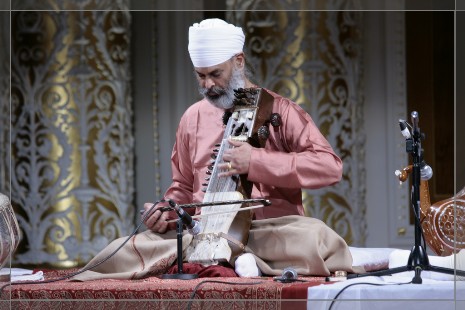namdhari world
Main menu:
- Home Page
- Kuka Faith
- History
- Sikh Gurus
- Namdhari Gurus
- Freedom Fighter - Satguru Ram Singh Ji
- Warrior of Peace
- Non-Cooperation Movement page 1
- Non-Cooperation Movment page 2
- Kuka Postal Service
- No Trial
- Battle for recognition as part of India's struggle for freedom
- Plaque at Ludhiana Railway Station
- Ram Singh Kuka by G.K.Venkateshamurthy
- Social Reforms by Satguru Ram Singh Ji
- Birth of Sant Khalsa
- Kuka Movement - by Film division of Government of India
- KUKA LEHAR - India's first war for independance (1856)
- Satguru Jagjit Singh Ji
- Contradictions
- Historical Quotes
- Vaisakhi - 1699
- Gurmukhi Script
- Sikh Women
- Knowlegde Bank
- Connections
- Places to visit
- Resources
- Music World
- Calendar
- Sports
- ETC...
Surjit Singh
Music World > Namdhari Artists

Hailing from Delhi, Surjeet Singh is a principal disciple of the great sarangi player , Pandit Ram Narayan.
Born in Delhi in 1961, he was initiated into music by Sri Satguru Jagjit Singh Ji Maharaj, at a very early age. At Sri Bhaini Sahib he received training in playing the dillruba from Sants Gurdev Singh and Harbhajan Singh. He later received training in vocal classical music but his passion for the sarangi eventually led him to become the disciple of Pandit Ram Narayan settled for the sarangi in 1977. He spent the next 15 years of his life in training and now is an outstanding sarangi player in his own right. In recent years Surjeet Singh has also received guidance from Pandit Hanuman Prasad Mishra (Banaras Gharana).
Surjeet Singhs technical mastery, along with the richness of his musical ideas and his traditional approach has won him admiration throughout the world. His large repertoire of Khayal, Thumris with an artistry, which makes a deep impact on the adept and uninitiated listener alike.
Surjeet Singh has played extensively in India at various important festivals giving solo recitals. He has accompanied leading musicians - Ustad Salamat Ali Khan, Ustad fateh Ali Khan , Pandit Rajan-Sajan Mishra and Shri L K Pandit amongst others. He is a graded artist of All India Radio.
He has played at numerous venues in Thailand, East Africa, USA, UK and other European countries. He has build in own niche and has received praise and recognition both as a solo and as an accompanying artist.
Surjeet Singh has built his own niche and has received praise and recognition both as a solo and as an accompanying artist. He is a leading figure and a reviver of Sarangi in Sikh community as a Performer and Teacher. Currently he is the head of department for Bow instruments in Raj Academy of Asian Music UK.
Discography:
1) sarangi recital presented by namdhari sangat & raj academy of asian music.
2) mere mun - collection of gurbani ragas.
The name Sarangi is said to mean ‘sau rang’ (100 colours) or ‘sa rang’ (colours whatever it touches). It is the most important bowed instrument of North Indian music.
Like most stringed instruments the sarangi has a wooden sound box. The technique used to play the sarangi is to play the main strings with the tops of the fingernails of the left hand. It is bowed with a heavy bow like the ones used for the esraj and dilruba. The instrument has no frets or fingerboard; the strings float in the air. Pitch is determined by sliding the fingernail against the string rather than pressing it against a fingerboard (like violin). This allows subtle glides and embellishments, which are extremely close to the human voice. This instrument is made of a block of tun wood, with a goat skin stretched over the body. There are 3 main playing strings and 30 to 40 sypathetic strings.
The Sarangi of the Sikhs was brought in and promoted by the sixth Guru, Hargobind Sahib, to sing the ballads from Siri Guru Granth Sahib or from Bhai Guru Das’ poetry. Vaaran (ballads) are to be found in great number among these works, and they incorporate an aggressive approach to singing and expression (an attack on the mind).
It appears that the Sarangi was a folk instrument long before it came to be accepted in classical music as an accompanying instrument. This was most probably during the rise of the Khayal gayaki (style) at the time of Mohammed Shah ‘Rangila’. By the nineteenth century, the Sarangi came to be associated with dancing girls and courtesans, and was used as the standard instrument for accompanying Khayal, Thumri, and occasionally for Dhrupad. However, its popularity is on the decline, partly because of these negative associations, and partly because of the technical difficulties in tuning and playing the instrument.